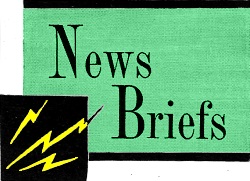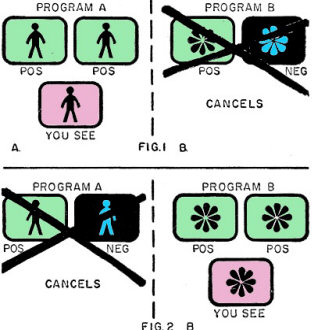|
November 1957 Radio-Electronics
 [Table of Contents] [Table of Contents]
Wax nostalgic about and learn from the history of early electronics.
See articles from Radio-Electronics,
published 1930-1988. All copyrights hereby acknowledged.
|
For many years, Radio-Electronics
magazine featured a monthly column entitled "News Briefs," which as the name suggests
reported on breaking industry news. It could be the announcement of a significant
new invention, research, a tradeshow event, recognition of someone's achievement,
or any item deemed worthy of making public. Some months flourished with interesting
(to me) tidbits while others had none. The November 1957 issue was middle of the
road, so to speak. One that might interest you is that RETMA Changes Name. The
Radio-Electronics - Television Manufacturers Association has changed its
name to
Electronic
Industries Association (EIA) - the name it still bears to this day (except
the "A" now stands for "Alliance"). Imagine the level of bureaucracy and expense
for change that "A." Also, a scheme to simultaneously broadcast a free-TV and a
pay-TV show is introduced. A new battery concept using hydrogen and oxygen, called
a "fuel cell," is presented as well (now commonplace).
New Briefs:
11/1957
| 8/1958 |
11/1959 |
2/1960 |
4/1960 |
8/1960 |
3/1961 |
5/1961 |
6/1961 |
12/1961 |
3/1963 |
4/1963 |
8/1963 |
9/1963 |
8/1964 |
12/1964 |
1/1967 |
3/1967 |
4/1967 |
9/1967 |
4/1968
News Briefs
 RETMA Changes Name. The Radio-Electronics
- Television Manufacturers Association has changed its name to Electronic Industries
Association (EIA). This is hoped to be the end of a series of changes, by which
the Radio Manufacturers Association (RMA) successively became RTMA and then RETMA
before adopting its present title. RETMA Changes Name. The Radio-Electronics
- Television Manufacturers Association has changed its name to Electronic Industries
Association (EIA). This is hoped to be the end of a series of changes, by which
the Radio Manufacturers Association (RMA) successively became RTMA and then RETMA
before adopting its present title.
 2 TV Programs to a Channel, making
it possible for one to be used for pay-TV and the other for free viewing, has been
proposed to the FCC by Blonder-Tongue Labs. Though exact technical details are not
yet available, it was revealed that two pairs of signals are to be transmitted by
the TV station, one pair for program A and the other for program B. Program A consists
of two positive units (see Fig. 1-a) which combine to produce a show on the viewer's
screen. However, program B is made up of one positive and one negative signal. (see
Fig. 1-b). These signals cancel each other and do not appear. 2 TV Programs to a Channel, making
it possible for one to be used for pay-TV and the other for free viewing, has been
proposed to the FCC by Blonder-Tongue Labs. Though exact technical details are not
yet available, it was revealed that two pairs of signals are to be transmitted by
the TV station, one pair for program A and the other for program B. Program A consists
of two positive units (see Fig. 1-a) which combine to produce a show on the viewer's
screen. However, program B is made up of one positive and one negative signal. (see
Fig. 1-b). These signals cancel each other and do not appear.
When you wish to see program B, a Bi-Tran decoding signal is fed to the receiver.
The decoding signal reverses the negative image in the B program to positive and
the B program is received (see Fig. 2-b). Simultaneously, one of the positive signals
for the A program is reversed to negative and the A program is cancelled out (see
Fig. 2-a). As applied to pay TV, the normal (free) program would come through on
the A channel and the pay program on the B channel. To watch the pay program, the
set would be switched to the B channel. This would bring decoding signals-carried
on the regular telephone line-to the receiver, and at the same time would transmit
information as to the program selected back to the telephone office. The payment
could be included in the viewer's monthly phone bill.
Modification of both receiving and transmitting equipment would, of course, be
necessary.
In military uses the Bi-Tran system could allow transmission of classified information
as only persons who knew the proper decoding signals could decipher the signal.
Doubling the number of TV channels would also permit educational programs and
public service information as required by police and fire departments and hospitals
-to be transmitted without disturbing any existing programs.
New Battery makes electricity direct from gases, by feeding
oxygen and hydrogen through its electrodes. The simplified diagram shows the basic
operation of this new battery, called a fuel cell. Hydrogen and oxygen enter the
cell through specially treated, hollow, porous carbon electrodes. When the gases
diffuse to the electrodes' surfaces, they come into contact with the electrolyte,
a solution of potassium hydroxide. At the hydrogen electrode, the electrochemical
reaction releases an electron which flows through the external circuit and is accepted
at the oxygen electrode. This flow of electrons is the current that powers electrical
equipment. Ionic conductivity through the electrolyte completes the circuit, positive
potassium ions picking up their missing electrons at the oxygen anode. Water formed
in the reaction passes from the cell in the hydrogen stream. There is no deterioration
of electrodes or electrolyte, and the cell can operate indefinitely as long as "fuel"
(oxygen and hydrogen) is supplied to it. Research has indicated that the optimum
fuel-cell design will deliver approximately 1 kilowatt from a unit 1 cubic foot
in volume. Potential across the terminals is about 1 volt.
As a producer of electrical energy, the fuel cell, developed by the National
Carbon Co., depends on a practical and economical source of hydrogen. This gas,
at present, is expensive and requires relatively bulky containers.
Posted December 28, 2021
|









 RETMA Changes Name. The Radio-Electronics
- Television Manufacturers Association has changed its name to Electronic Industries
Association (EIA). This is hoped to be the end of a series of changes, by which
the Radio Manufacturers Association (RMA) successively became RTMA and then RETMA
before adopting its present title.
RETMA Changes Name. The Radio-Electronics
- Television Manufacturers Association has changed its name to Electronic Industries
Association (EIA). This is hoped to be the end of a series of changes, by which
the Radio Manufacturers Association (RMA) successively became RTMA and then RETMA
before adopting its present title. 
